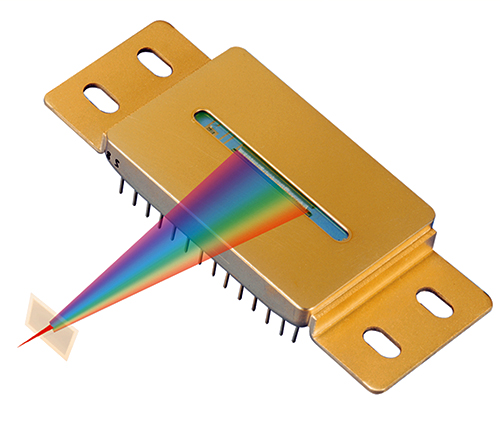Offering an Array of Improvements
A long-time veteran of NASA's Small Business Innovation Research (SBIR) program successfully incorporated an SBIR-funded technology in the commercialization of several products. Sensors Unlimited, Inc., of Princeton, New Jersey, with SBIR funding from NASA's Langley Research Center, Goddard Space Flight Center, Marshall Space Flight Center, and the Jet Propulsion Laboratory, developed a monolithic focal plane array for near-infrared imaging. Innovative technologies derived from this development have enabled telecommunication companies to optimize existing bandwidth in their fiber-optic networks.
The Internet offers an infinitely expanding demand for information. Early web sites were mostly text based; however, an increase in technology led to more graphic-oriented sites, resulting in larger volumes of data, creating a need for faster connections and increased bandwidth. Sensors Unlimited, recognizing these new requirements, developed one- (1-D) and two-dimensional (2-D) imaging arrays consisting of a highly reliable InGaAs p-I-n diode as a photodetector for monitoring a variety of applications, including single element device applications in receivers.
A 1-D imager is comprised of a one-dimensional, linear array of photodiodes to detect light, and a readout integrated circuit (ROIC) to interpret the image. A 2-D imager includes the same ROIC, but contains a two-dimensional array of photodiodes, increasing light detection and therefore, performance. Sensors Unlimited developed a method of combining the photodiode array and the ROIC monolithically in an infrared imager. The high-performance InGaAs array is integrated with a junction field effect transistor (JFET) that acts as a switching element for each pixel. Advantages of such a detector include low dark current, high quantum efficiency, subnanosecond response, and room temperature operation.
The InGaAs 1-D and 2-D arrays have many applications. For example, they monitor the performance of dense wavelength division multiplexing (DWDM) systems--the process of packaging many channels into a single fiber-optic cable. Sensors Unlimited draws on the example of a prism in front of a fiber-optic cable to demonstrate how multiple wavelengths of light are separated from one another, With DWDM, each of these colors is a separate channel carrying a separate stream of data. Sensors Unlimited commercially offers its LX™ and LY™ Series InGaAs linear arrays for reliable DWDM performance monitoring. The LX and LY arrays enable instrument module designs with no moving parts, which provides for superior uniformity, and fast, linear outputs that remain stable over a wide temperature range.
Many infrared imaging arrays are hybrid devices. The photodetectors utilized in these systems are interconnected to silicon multiplexer readout arrays by either flip-chip or wire bonding. A hybrid system is not the most efficient system due to the complex manufacturing steps and additional handling processes involved. Sensors Unlimited also produces linear photodiode arrays for optical monitoring by incorporating an innovative, scalable, manufacturing process, allowing production capacity to stay ahead of market needs. This permits optical networks employing the array to grow proportionately to the demand for high-speed bandwidth. Sensors Unlimited's technology facilitates telecommunication providers' needs to increase bandwidth in order to support a high volume of network traffic. At the same time, the technologies obtained from the monolithic focal plane array have the potential for reducing costs, while increasing performance from Sensors Unlimited's current product lines.
According to Sensors Unlimited president, Greg Olsen, the support of SBIR funding has helped to build a technology company with tremendous value. As a leading supplier of InGaAs technology and products, Sensors Unlimited will continue to be a dominant force in the fiber-optic industry, because we make the products that allow high bandwidth Internet operations, which is an area experiencing tremendous growth. We owe our auspicious start to the SBIR awards, which enabled us to conduct state-of-the-art research and development and secure partnerships that we need to bring our technology to the market.
LX™ Series InGaAs linear photodiode array is a trademark of Sensors Unlimited, Inc.
LY™ Series InGaAs linear photodiode array is a trademark of Sensors Unlimited, Inc.

Just as a prism separates colors into different channels, Sensors Unlimited's linear photodiode array separates multiple streams of data into fast, linear outputs that remain stable over a wide temperature range.













